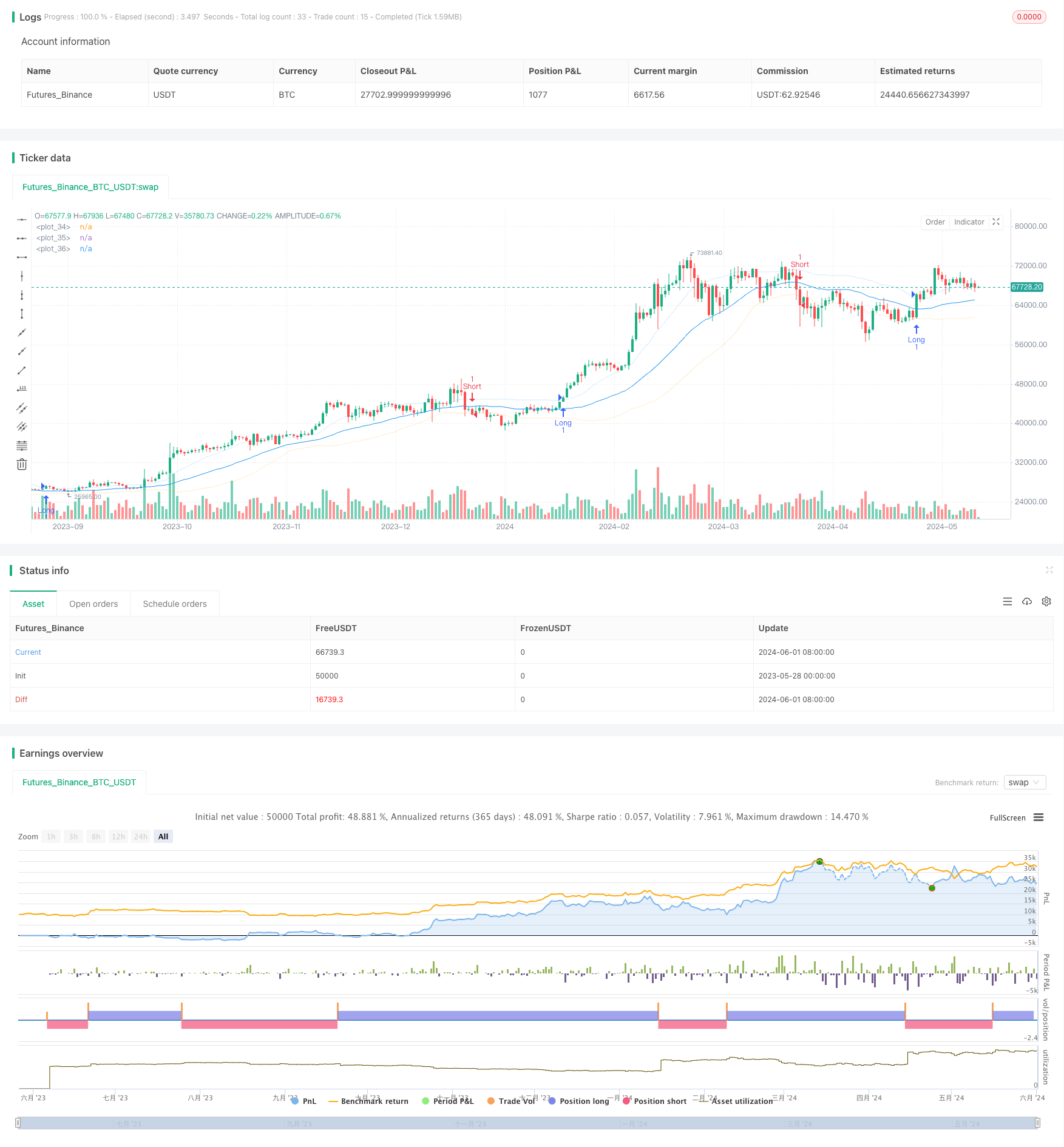
概述
该策略使用布林带(Bollinger Bands)作为主要指标,通过分析价格与上下轨的关系,在特定条件下进行交易。策略的主要思路是:当收盘价突破上轨时做多,突破下轨时做空,同时使用相反信号平仓,以此捕捉价格的波动。
策略原理
- 计算布林带的中轨、上轨和下轨。中轨为收盘价的简单移动平均线,上下轨为中轨加减一定倍数的标准差。
- 当收盘价突破上轨时,触发做多条件,开仓做多。
- 当收盘价突破下轨时,触发做空条件,开仓做空。
- 当持有多头仓位时,如果出现做空条件,则平多头仓位。
- 当持有空头仓位时,如果出现做多条件,则平空头仓位。
策略优势
- 布林带能够有效反映价格的波动情况,使用其作为交易信号具有一定的可靠性。
- 策略逻辑清晰,容易理解和实现。
- 在趋势行情中,该策略可以很好地捕捉价格的波动,获得较好的收益。
- strategeya5 a4.该数y不采用过多指标,减少了噪声干扰,提高了信号的有效性。
策略风险
- 在震荡行情中,该策略可能会出现频繁交易的情况,导致较高的交易成本。
- 布林带参数的选择对策略性能有很大影响,不恰当的参数可能导致策略失效。
- 该策略未设置止损,在行情急剧反转时可能面临较大风险。
- 策略未考虑交易品种的特性,对于不同的交易品种可能需要调整参数。
策略优化方向
- 引入其他指标,如趋势指标或震荡指标,以确认布林带信号,提高交易准确性。
- 对参数进行优化,如布林带的周期和标准差倍数,以适应不同的市场状况。
- 设置合理的止损止盈,控制单笔交易风险。
- 根据交易品种的特性,如波动率、流动性等,对策略进行调整。
- 考虑引入仓位管理,根据市场状况动态调整仓位,提高收益风险比。
总结
该策略以布林带为核心,通过分析价格与布林带的关系,在特定条件下进行交易。策略逻辑清晰,易于理解和实现,在趋势行情中可以获得较好的收益。但同时也存在一些风险,如频繁交易、参数选择不当等。通过引入其他指标、优化参数、设置止损止盈等方式,可以进一步提升策略的性能,更好地适应不同的市场环境。
策略源码
/*backtest
start: 2023-05-28 00:00:00
end: 2024-06-02 00:00:00
period: 1d
basePeriod: 1h
exchanges: [{"eid":"Futures_Binance","currency":"BTC_USDT"}]
*/
//@version=5
strategy("Bollinger Bands Strategy", overlay=true)
src = input(close)
length = input.int(34, minval=1)
mult = input.float(2.0, minval=0.001, maxval=50)
basis = ta.sma(src, length)
dev = ta.stdev(src, length)
dev2 = mult * dev
upper1 = basis + dev
lower1 = basis - dev
upper2 = basis + dev2
lower2 = basis - dev2
// Long Condition: Close above Upper Bollinger Band
longCondition = close > upper1
// Short Condition: Close below Lower Bollinger Band
shortCondition = close < lower1
// Strategy Entry and Exit
strategy.entry("Long", strategy.long, when = longCondition)
strategy.entry("Short", strategy.short, when = shortCondition)
// Close Long Position when Short Condition is Met
strategy.close("Long", when = shortCondition)
// Close Short Position when Long Condition is Met
strategy.close("Short", when = longCondition)
// Plotting Bollinger Bands
plot(basis, color=color.blue)
plot(upper1, color=color.new(color.blue, 80))
plot(lower1, color=color.new(color.orange, 80))
相关推荐